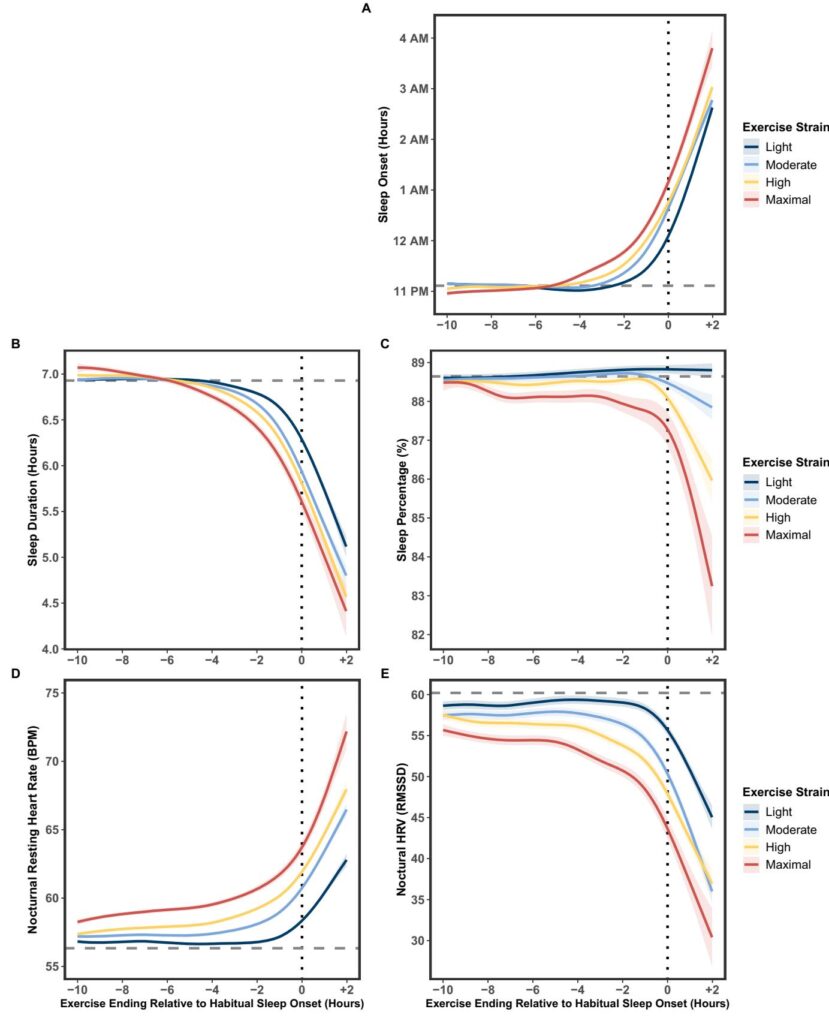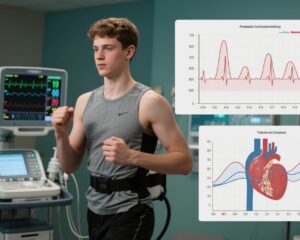Introduction
Public health guidelines widely endorse exercise as a vital lifestyle intervention to enhance sleep health and reduce risk of chronic disease. The relationship between physical activity and sleep is bidirectional and multifaceted, involving physiological mechanisms such as thermoregulation, mood regulation, metabolic expenditure, and circadian rhythm synchronization. However, strenuous exercise performed close to bedtime may provoke heightened sympathetic nervous system arousal, potentially disrupting subsequent sleep initiation and maintenance. Traditional sleep hygiene guidelines have thus typically discouraged intense physical activity within hours of bedtime. Yet, recent meta-analyses report minimal adverse effects of evening exercise when intensity or duration are assessed individually, prompting the need to examine the combined impact of exercise intensity and duration—conceptualized as exercise strain—on sleep and related autonomic parameters.
Study Design and Population
This retrospective cohort study included 14,689 physically active adults, predominantly male (73.8%), with a mean age of 37.9 years, who wore a validated wrist-worn biometric device (WHOOP) continuously over one year, contributing a total of 4,084,354 person-nights. Participants logged an average of approximately 123 exercise sessions per year. Inclusion criteria ensured a minimum of 350 days of device wear and at least 50 exercise bouts occurring from 10 hours before to 2 hours after habitual sleep onset to allow within-subject comparison of how exercise timing and strain relate to sleep outcomes.
Methods: Exercise Timing and Strain Quantification
Exercise timing was anchored to individual habitual sleep onset (mean sleep onset adapted for weekday/weekend and season) and actual sleep onset for secondary analyses, to account for interindividual variability in sleep schedules. Exercise strain was quantified via summated heart rate zones score (SHRZS), which incorporates exercise intensity and duration, categorized into light (461) strain groups. This objective metric allowed differentiation of cardiometabolic load during exercise bouts.
Key Findings
Sleep Onset
Late evening exercise was dose-dependently associated with delayed sleep onset, particularly at higher exercise strain levels. Exercise completed 4 or more hours before habitual sleep onset did not delay sleep. Specifically, maximal strain exercise ending 2 hours before habitual sleep onset delayed bedtime by approximately 36 minutes compared to light exercise, and if exercise ended 2 hours after habitual sleep onset, delay extended to 80 minutes.
Sleep Duration and Quality
When exercise concluded 26 hours or more before sleep, higher strain correlated positively with longer sleep. Conversely, exercise ending within the 6 hours before to 2 hours after sleep onset reduced sleep duration and quality in a dose-dependent manner, with greater effects at higher strain. Maximal strain exercise ending 2 hours prior to sleep shortened duration by 22.2 minutes and impaired sleep quality by nearly 1%, effects that intensified if exercise ended after sleep onset.
Nocturnal Autonomic Function (RHR and HRV)
Increased exercise strain was consistently linked to elevated nocturnal resting heart rate (RHR) and reduced heart rate variability (HRV), markers of sympathetic dominance and parasympathetic withdrawal, respectively. The most pronounced autonomic disruptions occurred when exercise ended within 4 hours before to 2 hours after sleep onset. Maximal strain exercise ending 2 hours before sleep onset raised nocturnal RHR by 3.9 beats/min and lowered HRV by 14.1%, with larger effects if exercise occurred closer to or after sleep onset.
Secondary and Exploratory Analyses
Analyses using actual sleep onset timing reaffirmed dose-dependent relationships of late and high-strain exercise with poorer sleep and altered autonomic metrics. These associations were consistent across gender, age groups, and BMI categories.
Discussion
This large-scale study confirms that both the timing and intensity-duration combination of evening exercise—exercise strain—have significant dose-dependent effects on sleep timing, duration, quality, and nocturnal autonomic regulation. Elevated exercise strain near bedtime appears to delay parasympathetic reactivation necessary for sleep initiation, reflected in increased nocturnal RHR and decreased HRV. These disruptions underline the biological plausibility linking strenuous late exercise to sleep impairment.
Importantly, exercising more than 4 hours before habitual sleep onset, even at maximal strain, was not associated with adverse sleep outcomes, supporting guidelines advocating adequate pre-sleep recovery periods. Light to moderate intensity exercises conducted closer to bedtime had minimal impact, highlighting that exercise strain magnitude is a critical determinant.
Behavioral factors, like post-exercise dietary intake (e.g., caffeine, carbohydrates, alcohol) and exposure to bright light in evening exercise environments, may compound these physiological effects and warrant further study.
Clinical and Public Health Implications
The findings suggest health professionals should advise individuals aiming to optimize sleep health to conclude exercise sessions at least four hours before sleep onset when possible. When late evening activity is inevitable, selecting lower strain exercise modalities may mitigate disruption. This nuanced guidance surpasses traditional blanket prohibitions and aligns with emerging evidence on safe evening physical activity. Notably, this has ramifications for athletes and competitive schedules where evening maximal exertion is common.
Limitations and Future Directions
Limitations include the inability to assess sleep onset latency due to absence of sleep attempt data, potential underestimation of strain from brief, high-effort strength training exercises, and lack of contextual confounders such as ambient light exposure. The sample comprised physically active adults, which may limit generalizability to sedentary populations. Future studies could incorporate behavioral assessments, finer measurement of pre-sleep conditions, and explore populations with lower fitness levels.
Conclusion
This comprehensive, real-world investigation elucidates a clear dose-response link between evening exercise timing and strain with sleep and nocturnal autonomic function. Timely completion of exercise four or more hours before bedtime or opting for light strain exercise within close proximity to sleep may safeguard sleep quality and facilitate recovery. These insights refine public health recommendations and underscore the importance of personalized exercise scheduling for optimal sleep health.
References
Leota J, Presby DM, Le F, Czeisler MÉ, Mascaro L, Capodilupo ER, Wiley JF, Drummond SPA, Rajaratnam SMW, Facer-Childs ER. Dose-response relationship between evening exercise and sleep. Nat Commun. 2025 Apr 15;16(1):3297. doi: 10.1038/s41467-025-58271-x. PMID: 40234380; PMCID: PMC12000559.



